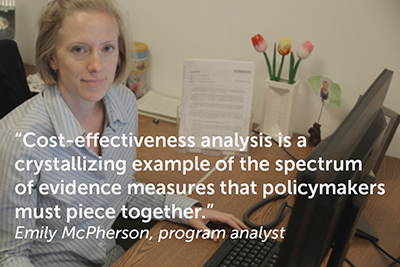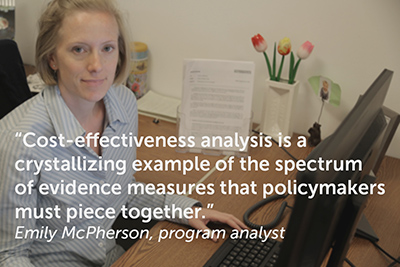Questions about what treatments and drugs health insurers should cover is necessarily controversial. I’m intrigued by how they decide whether a certain medication or treatment is worth the investment, and I find it exciting to influence decisions that affect so many lives.
In particular, I’ve been studying a method known as cost-effectiveness analysis (CEA), which has been long used in single-payer health systems such as those in Canada and the United Kingdom as evidence to support funding decisions.
 CEA compares a new treatment to the existing practice—specifically, the difference in treatment cost divided by the difference in treatment effectiveness. This is the incremental cost-effectiveness ratio (ICER), which is typically expressed as a dollar figure and corresponds to one year. It is often compared to per-capita gross domestic product (GDP) to give it some context; the goal is to compare it with how much economic output the average person would produce if he or she lived a year longer due to the new treatment. If the ICER is less than annual per-capita GDP, it is often taken to be cost-effective—meaning that society would benefit (or break even) from investing in extending the person’s life.
CEA compares a new treatment to the existing practice—specifically, the difference in treatment cost divided by the difference in treatment effectiveness. This is the incremental cost-effectiveness ratio (ICER), which is typically expressed as a dollar figure and corresponds to one year. It is often compared to per-capita gross domestic product (GDP) to give it some context; the goal is to compare it with how much economic output the average person would produce if he or she lived a year longer due to the new treatment. If the ICER is less than annual per-capita GDP, it is often taken to be cost-effective—meaning that society would benefit (or break even) from investing in extending the person’s life.
CEA can be an important decision-making tool, but on its own doesn’t provide a comprehensive picture of how well a drug or treatment works. CEA is a crystallizing example of the spectrum of evidence measures that policymakers must piece together—and why it’s so important for researchers to provide high quality, objective evidence to help decision makers solve the puzzle of how to best serve the public good. This mission inspires me in my work.
With a team of Canadian cancer researchers, I recently conducted a study comparing the cost of diagnostic genetic tests to the benefit of the information they provide—showing which treatments are likely to sustain the patient's cancer remission. This information allows the physician to select the least expensive treatment that would still be effective.
Our study found that the ICER result was $49,400 in 2014 Canadian dollars. Compared to Canada's annual per-capita GDP of about $55,000, this intervention would generally be considered cost-effective. The potential savings that this comparison uncovered is evidence that could support the decision to make upfront investment in genetic testing.
However, this analysis does not give a complete picture of patient health, because some treatments may make patients feel more ill than others. Our team is currently working on adding information to the equation, such as quality-of-life survey data, to see how it changes the results. We’re hopeful that our work will help provide Canadian authorities with the evidence they need to make an informed decision about investing in these genetic tests.
With its emphasis on the bottom line, the use of CEA is certainly controversial. That’s true both here in the United States—where we see ongoing debates over whether the U.S. government should adopt CEA in making coverage decisions for Medicare and Medicaid—and in countries where CEA is being used. For example, because the CEA approach is based on individual outcomes, some health policy stakeholders argue that it may undervalue drugs whose main benefits are long-term or population level. With its extensive use of CEA estimates, the U.K. government is often criticized for covering fewer drugs than other publicly funded health systems though it recently was praised for the rapid evaluation and approval of ipilimumab, a promising new immunotherapy treatment for advanced melanoma.
CEA will undoubtedly continue to play an important role in health policy decision making in many countries for years to come. I look forward to helping build evidence about the use of CEA and other tools that will serve as key pieces of this critical policymaking puzzle.



